How to use the asterisk character
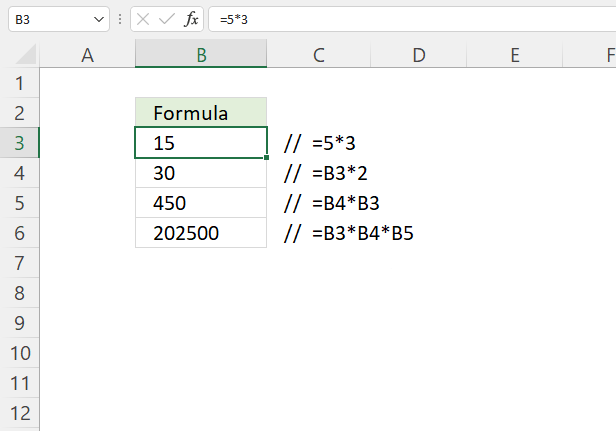
The asterisk character allows you to multiply numbers and boolean values in an Excel formula. It can also be used as a wildcard character in quite a few Excel functions.
I will in this article demonstrate when you can use the asterisk character.
Table of Contents
- How to multiply numbers in an Excel formula
- How to multiply a number and cell value
- How to multiply cell values
- How to multiply multiple cell values
- How to multiply values using an Excel function
- How to multiply functions in an Excel formula
- How to multiply boolean values - apply AND logic
- Arithmetics - order of operation
- Partial match VLOOKUP - asterisk character (wildcard)
- Asterisk not working
1. How to multiply numbers in an Excel formula

You can use numbers in an Excel formula, they are named constants or hard-coded numbers since they don't change unless the Excel user changes them.
To multiply constants simply use the asterisk character to calculate the multiplication between two constants. Here is a simple example:
Formula in cell B3:
The formula is calculated as soon as you press Enter on the keyboard, and the result is shown in the cell. The result from multiplication is called a product.
Use key F9 to calculate the result of any calculation, not just multiplication, here is how:
- Select the part in the formula you want to calculate using the mouse or keyboard.
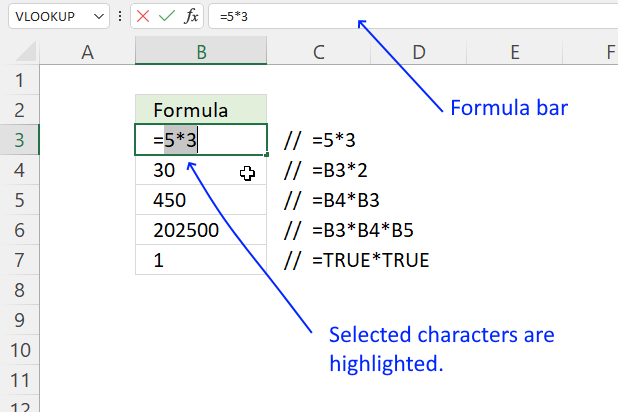
- Press function key F9.
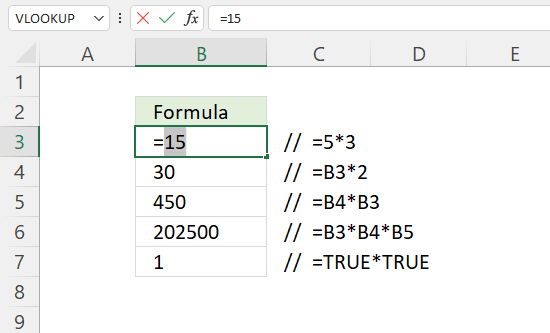
The cell and the formula bar show the result.
2. How to multiply a number and cell value
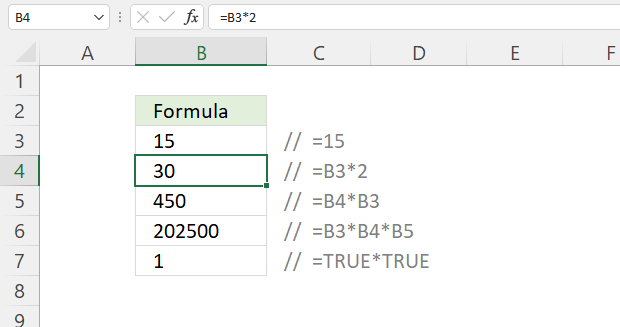
This example shows how to multiply a cell value with a constant.
Formula in cell B4:
Explaining formula
Step 1 - Cell reference, asterisk, and the constant
B3*2
Cell B3 is a relative cell reference meaning it will change accordingly if you copy cell B4 and paste to another cell on the worksheet.
Select B3 in the formula with the mouse and then press F9 to convert the relative cell reference to an absolute cell reference. An absolute cell reference has dollar signs before the column letter and row number like this $B$3.
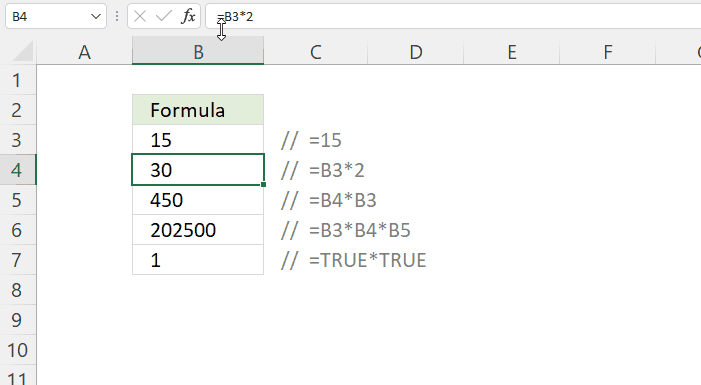 An absolute cell reference stays the same when you copy the cell and paste into other cells.
An absolute cell reference stays the same when you copy the cell and paste into other cells.The asterisk character performs multiplication between two numbers in an Excel formula.
2 is a constant.
Step 2 - Evaluate the formula
B3*2
becomes
15*2
and returns 30 in cell B4
3. How to multiply cell values
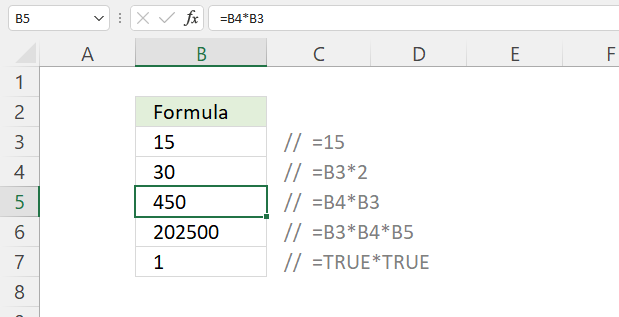
The asterisk character lets you multiply two cell values using cell references.
Formula in cell B5:
Explaining formula
B4*B3
becomes
30*15
and returns 450
4. How to multiply multiple cell values
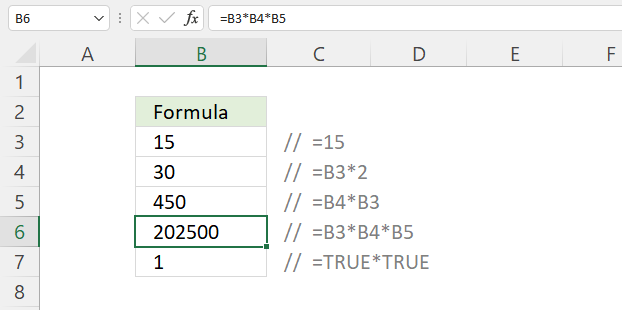
You can use the asterisk character almost as many times as you like in an Excel formula. This example shows how to multiply three cell values.
Formula in cell B5:
Explaining formula
B3*B4*B5
becomes
15*30*450
and returns 202500
5. How to multiply values using an Excel function
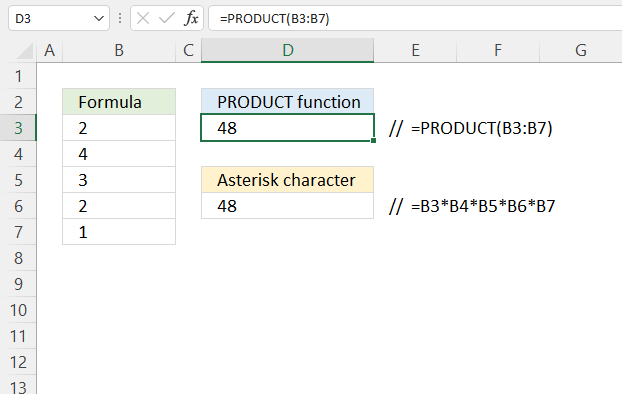
The PRODUCT function lets you multiply multiple cell values easily.
Formula in cell D3:
Explaining formula
Step 1 - Populate arguments
The PRODUCT function returns the product of the numbers given in the argument.
Function syntax: PRODUCT(number1, [number2], ... )
number1 - B3:B7
PRODUCT(B3:B7)
Step 2 - Evaluate the PRODUCT function
PRODUCT(B3:B7)
becomes
PRODUCT({2;4;3;2;1})
and returns 48
2*4*3*2*1 equals 48
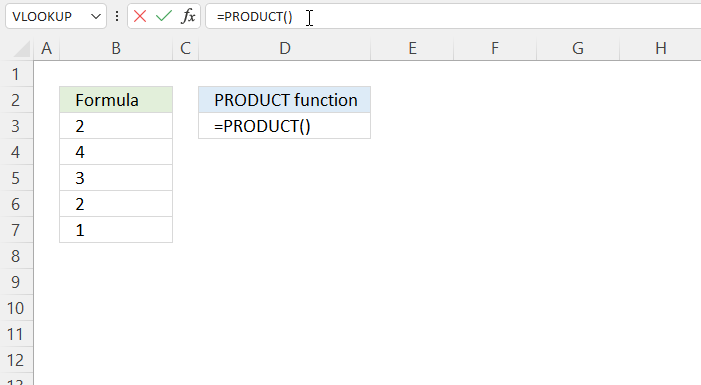
6. How to multiply functions in an Excel formula
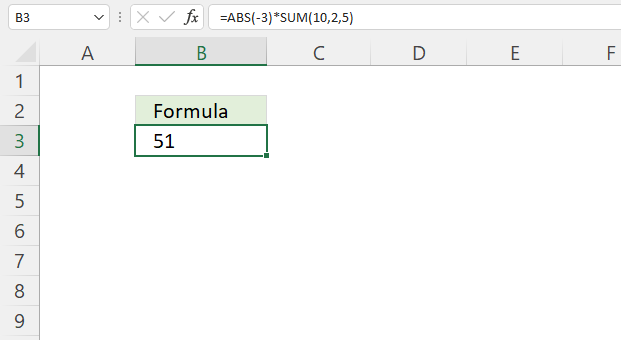
This example shows how to multiply two different Excel functions.
Formula in cell D3:
Explaining formula
Step 1 - Evaluate ABS function
The ABS function converts negative numbers to positive numbers.
Function syntax: ABS(number)
ABS(-3)
returns 3
Step 2 - Evaluate SUM function
The SUM function allows you to add numerical values, the function returns the sum in the cell it is entered in. The SUM function is cleverly designed to ignore text and boolean values, adding only numbers.
Function syntax: SUM(number1, [number2], ...)
SUM(10,2,5)
returns 17
Step 3 - Multiply numbers
ABS(-3)*SUM(10,2,5)
becomes
3*17
equals 51
7. How to multiply boolean values - apply AND logic
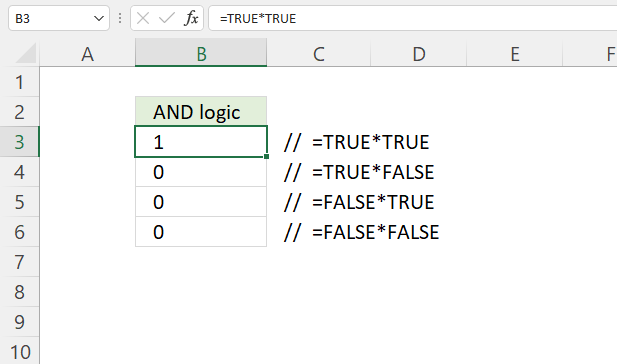
The asterisk character lets you multiply both numbers and boolean values in an Excel formula, however, you can't multiply text values.
If you multiply boolean values you are in fact performing AND logic to the calculation and converting the boolean values to their numerical equivalents, here is why.
TRUE * TRUE equals 1 (TRUE)
TRUE * FALSE equals 0 (FALSE)
FALSE * TRUE equals 0 (FALSE)
FALSE * FALSE equals 0 (FALSE)
AND logic meaning both or more boolean values must all be TRUE in order to return TRUE.
8. Arithmetics - order of operation
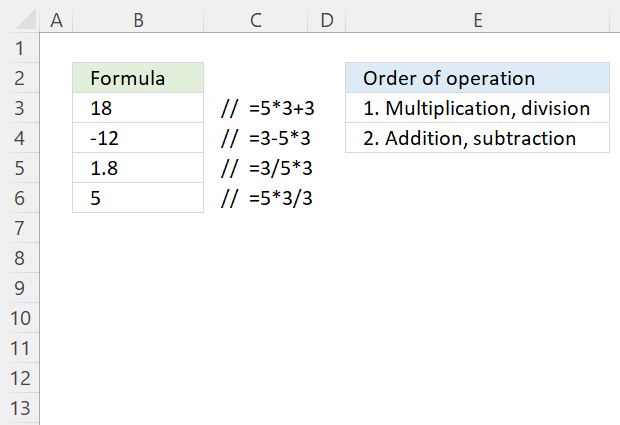
This example shows that multiplication and division are calculated before addition and subtraction.
Formula in cell B3:
Explaining the formula
Step 1 - Calculate the product
5*3
equals 15
Step 2 - Calculate the addition
15 + 3
equals 18
8.1 Multiplication and subtraction

Formula in cell B3:
Multiplication is calculated before subtraction
3-5*3
becomes
3-15
equals -12
9. Partial match VLOOKUP - asterisk character (wildcard)
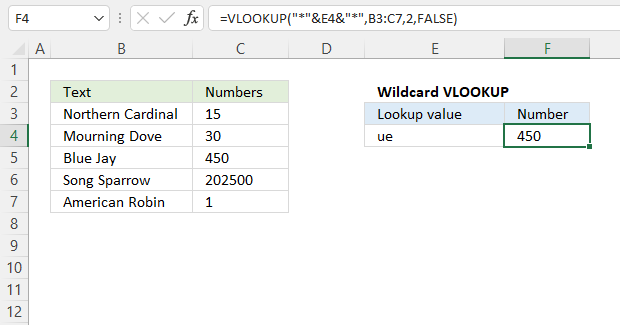
The asterisk character lets you also perform a wildcard match, the asterisk matches zero to multiple numbers of characters in Excel. This example demonstrates two asterisks, one before and one after the lookup value.
This makes the VLOOKUP function look for a cell value that contains the search string or in other words a partial match.
Formula in cell F4:
This formula looks for the specified value in cell E4 in cell range B3:B7 and returns the adjacent value in cell range C3:C7 on the same row.
Explaining formula
Step 1 - Append asterisks to cell reference
The ampersand character lets you concatenate values in an Excel formula, this example demonstrates how to append asterisks to a particular cell reference.
"*"&E4&"*"
The double quotes are needed in order to encapsulate text values in an Excel formula.
Step 2 - Populate the VLOOKUP arguments
The VLOOKUP function lets you search the leftmost column for a value and return another value on the same row in a column you specify.
Function syntax: VLOOKUP(lookup_value, table_array, col_index_num, [range_lookup])
lookup_value - "*"&E4&"*"
table_array - B3:C7
col_index_num - 2
[range_lookup] - FALSE
becomes
VLOOKUP("*"&E4&"*",B3:C7,2,FALSE)
Step 3 - Evaluate the VLOOKUP function
VLOOKUP("*"&E4&"*",B3:C7,2,FALSE)
becomes
VLOOKUP("*ue*", {"Northern Cardinal", 15;"Mourning Dove", 30;"Blue Jay", 450;"Song Sparrow", 202500;"American Robin", 1}, 2, FALSE)
and returns
450
10. Asterisk not working

- The asterisk character needs numerical or boolean values as input values, text values won't work.This is demonstratedin cell B4.
- An error in earlier steps will propagate and will be returned, this is shown in cell B5.
10.1 Troubleshooting the error value

When you encounter an error value in a cell a warning symbol appears, displayed in the image above. Press with mouse on it to see a pop-up menu that lets you get more information about the error.
- The first line describes the error if you press with left mouse button on it.
- The second line opens a pane that explains the error in greater detail.
- The third line takes you to the "Evaluate Formula" tool, a dialog box appears allowing you to examine the formula in greater detail.
- This line lets you ignore the error value meaning the warning icon disappears, however, the error is still in the cell.
- The fifth line lets you edit the formula in the Formula bar.
- The sixth line opens the Excel settings so you can adjust the Error Checking Options.
Here are a few of the most common Excel errors you may encounter.
#NULL error - This error occurs most often if you by mistake use a space character in a formula where it shouldn't be. Excel interprets a space character as an intersection operator. If the ranges don't intersect an #NULL error is returned. The #NULL! error occurs when a formula attempts to calculate the intersection of two ranges that do not actually intersect. This can happen when the wrong range operator is used in the formula, or when the intersection operator (represented by a space character) is used between two ranges that do not overlap. To fix this error double check that the ranges referenced in the formula that use the intersection operator actually have cells in common.
#SPILL error - The #SPILL! error occurs only in version Excel 365 and is caused by a dynamic array being to large, meaning there are cells below and/or to the right that are not empty. This prevents the dynamic array formula expanding into new empty cells.
#DIV/0 error - This error happens if you try to divide a number by 0 (zero) or a value that equates to zero which is not possible mathematically.
#VALUE error - The #VALUE error occurs when a formula has a value that is of the wrong data type. Such as text where a number is expected or when dates are evaluated as text.
#REF error - The #REF error happens when a cell reference is invalid. This can happen if a cell is deleted that is referenced by a formula.
#NAME error - The #NAME error happens if you misspelled a function or a named range.
#NUM error - The #NUM error shows up when you try to use invalid numeric values in formulas, like square root of a negative number.
#N/A error - The #N/A error happens when a value is not available for a formula or found in a given cell range, for example in the VLOOKUP or MATCH functions.
#GETTING_DATA error - The #GETTING_DATA error shows while external sources are loading, this can indicate a delay in fetching the data or that the external source is unavailable right now.
10.2 The formula returns an unexpected value

To understand why a formula returns an unexpected value we need to examine the calculations steps in detail. Luckily, Excel has a tool that is really handy in these situations. Here is how to troubleshoot a formula:
- Select the cell containing the formula you want to examine in detail.
- Go to tab “Formulas” on the ribbon.
- Press with left mouse button on "Evaluate Formula" button. A dialog box appears.
The formula appears in a white field inside the dialog box. Underlined expressions are calculations being processed in the next step. The italicized expression is the most recent result. The buttons at the bottom of the dialog box allows you to evaluate the formula in smaller calculations which you control. - Press with left mouse button on the "Evaluate" button located at the bottom of the dialog box to process the underlined expression.
- Repeat pressing the "Evaluate" button until you have seen all calculations step by step. This allows you to examine the formula in greater detail and hopefully find the culprit.
- Press "Close" button to dismiss the dialog box.

There is also another way to debug formulas using the function key F9. F9 is especially useful if you have a feeling that a specific part of the formula is the issue, this makes it faster than the "Evaluate Formula" tool since you don't need to go through all calculations to find the issue.
- Enter Edit mode: Double-press with left mouse button on the cell or press F2 to enter Edit mode for the formula.
- Select part of the formula: Highlight the specific part of the formula you want to evaluate. You can select and evaluate any part of the formula that could work as a standalone formula.
- Press F9: This will calculate and display the result of just that selected portion.
- Evaluate step-by-step: You can select and evaluate different parts of the formula to see intermediate results.
- Check for errors: This allows you to pinpoint which part of a complex formula may be causing an error.
The image above shows cell reference B3 converted to hard-coded value using the F9 key. The asterisk function requires numerical values which is not the case in this example. We have found what is wrong with the formula.
Tips!
- View actual values: Selecting a cell reference and pressing F9 will show the actual values in those cells.
- Exit safely: Press Esc to exit Edit mode without changing the formula. Don't press Enter, as that would replace the formula part with the calculated value.
- Full recalculation: Pressing F9 outside of Edit mode will recalculate all formulas in the workbook.
Remember to be careful not to accidentally overwrite parts of your formula when using F9. Always exit with Esc rather than Enter to preserve the original formula. However, if you make a mistake overwriting the formula it is not the end of the world. You can “undo” the action by pressing keyboard shortcut keys CTRL + z or pressing the “Undo” button
10.3 Other errors
Floating-point arithmetic may give inaccurate results in Excel - Article
Floating-point errors are usually very small, often beyond the 15th decimal place, and in most cases don't affect calculations significantly.
More than 1300 Excel formulasExcel categories
Leave a Reply
How to comment
How to add a formula to your comment
<code>Insert your formula here.</code>
Convert less than and larger than signs
Use html character entities instead of less than and larger than signs.
< becomes < and > becomes >
How to add VBA code to your comment
[vb 1="vbnet" language=","]
Put your VBA code here.
[/vb]
How to add a picture to your comment:
Upload picture to postimage.org or imgur
Paste image link to your comment.